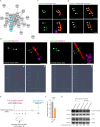Identification of New Ciliary Signaling Pathways in the Brain and Insights into Neurological Disorders
- PMID: 40623838
- PMCID: PMC12352538
- DOI: 10.1523/JNEUROSCI.0800-24.2025
Identification of New Ciliary Signaling Pathways in the Brain and Insights into Neurological Disorders
Abstract
Primary cilia are conserved sensory hubs essential for signaling transduction and embryonic development. Ciliary dysfunction causes a variety of developmental syndromes with neurological features and cognitive impairment whose basis mostly remains unknown. Despite connections to neural function, the primary cilium remains an overlooked organelle in the brain. Most neurons have a primary cilium; however, it is still unclear how this organelle modulates brain architecture and function, given the lack of any systemic dissection of neuronal ciliary signaling. Here, we present the first in vivo glance at the molecular composition of cilia in the mouse brain. We have adapted in vivo proximity-dependent biotin identification (iBioID), targeting the biotin ligase BioID2 to primary cilia in neurons of male and female mice. We identified tissue-specific signaling networks residing in neuronal cilia, including Eph/Ephrin signaling. We also uncovered a novel connection between primary cilia and gamma-aminobutyric acid signaling. Our iBioID ciliary network presents a wealth of new and neural-specific ciliary signaling proteins and yields new insights into neurological disorders. Our findings are a promising first step in defining the fundamentals of ciliary signaling and their roles in shaping neural circuits and behavior. In the future, this work can be extended to pathological conditions of the brain, with the goal of identifying ciliary signaling pathways disrupted in these disorders and the ultimate aim of finding novel therapeutic strategies.
Keywords: iBioID; mature brain; neurodevelopmental disorders; neurons; primary cilia.
Copyright © 2025 Loukil et al.
Conflict of interest statement
The authors declare no competing financial interests.
Figures





Update of
-
Identification of new ciliary signaling pathways in the brain and insights into neurological disorders.bioRxiv [Preprint]. 2023 Dec 21:2023.12.20.572700. doi: 10.1101/2023.12.20.572700. bioRxiv. 2023. Update in: J Neurosci. 2025 Aug 13;45(33):e0800242025. doi: 10.1523/JNEUROSCI.0800-24.2025. PMID: 38187761 Free PMC article. Updated. Preprint.
References
MeSH terms
Grants and funding
LinkOut - more resources
Full Text Sources
Medical
Molecular Biology Databases
Miscellaneous
